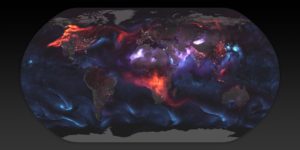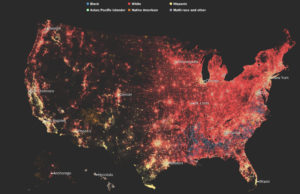Link to data visualization from the American Civil Liberties Union (ACLU): https://www.aclu.org/infographic-combating-mass-incarceration-facts
I picked the linked data visualization about mass incarceration in the United States for a few reasons: first, the topic itself is of interest to me. Secondly, this is an example of a non-profit organization trying to call the attention of the general public to facts that are uncomfortable and at times unbelievable, which presents an interesting challenge to grab their attention and then deliver a message that motivates them to act on the information provided.
Looking at the infographic, there are a few choices the author made that make it difficult to fully understand the information delivered, as well as things s/he got right. I’ll pick two as examples:
- Mistake: color and icon choices in the first quarter of the infographic. The author of the piece chose to use a row of 10 stars to represent the total global population and then again 10 stars to represent the total global prison population. Given that this is an infographic about the United States (signaled by the red, white, and blue colors throughout and the stars and stripes motif), I expected the denominator of each statistic shared to be the total selected U.S. population, and it was not, requiring more reading. Furthermore, the decision to represent the United States’ share of the global population in gray in the first row of stars was confusing (I typically think of gray coloring in a graphic as empty, rather than filled in…especially on a gray background). This is particularly true when in the next row of stars immediately following, the United States’ share of the global prison population is shown in red.
Suggested fix: Use other icons (perhaps people? Globes?) to represent the total global populations of interest, and use consistent coloring when highlighting the same country of interest (in this case, the United States).
- Well-done: The points made with the prison building graphic and the barbed wire fence spending graphic are clear and digestible. It was clear to me by looking at the illustrated prison building and reading the legend beneath it that roughly half of all prisoners are incarcerated for non-violent offenses (shown in blue) and half are jailed for violent offenses (shown in red). Looking just below, the author of the piece also did a good job showing that spending over time for corrections has grown much faster relative to spending on higher education.
Suggested improvement: I think the point about spending would have been made more real if there were numbers attached to the values of each bar in the bar chart. Though it is clear to see that the red bars (corrections spending) are higher than the blue bars (higher education spending), as a reader I’m left wondering how that gap has widened over time, and just how much we’re spending on incarceration in this country.
Looking at the infographic holistically, I fear that the main point (or points) are buried in a sea of information that is difficult to read through and digest quickly. Given that the audience for this infographic is the general public, the ACLU should revise this piece with the intent of making a few salient, related points using clear graphics that capture the challenge or teaching point they are trying to convey.



